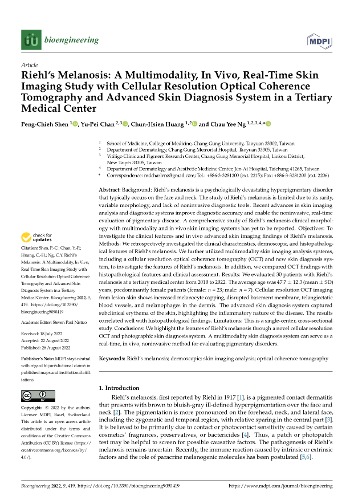Publications
- Home
- Publications
- Research Publications
- Riehl's Melanosis: A Multimodality, In Vivo, Real-Time Skin Imaging Study with Cellular Resolution Optical Coherence Tomography and Advanced Skin Diagnosis System in a Tertiary Medical Center
Riehl's Melanosis: A Multimodality, In Vivo, Real-Time Skin Imaging Study with Cellular Resolution Optical Coherence Tomography and Advanced Skin Diagnosis System in a Tertiary Medical Center

Abstract:
Background: Riehl’s melanosis is a psychologically devastating hyperpigmentary disorder that typically occurs on the face and neck. The study of Riehl’s melanosis is limited due to its rarity, variable morphology, and lack of noninvasive diagnostic tools. Recent advances in skin imaging analysis and diagnostic systems improve diagnostic accuracy and enable the noninvasive, real-time evaluation of pigmentary disease. A comprehensive study of Riehl’s melanosis clinical morphology with multimodality and in vivo skin imaging systems has yet to be reported. Objectives: To investigate the clinical features and in vivo advanced skin imaging findings of Riehl’s melanosis. Methods: We retrospectively investigated the clinical characteristics, dermoscopic, and histopathological features of Riehl’s melanosis. We further utilized multimodality skin imaging analysis systems, including a cellular resolution optical coherence tomography (OCT) and new skin diagnosis system, to investigate the features of Riehl’s melanosis. In addition, we compared OCT findings with histopathological features and clinical assessment. Results: We evaluated 30 patients with Riehl’s melanosis at a tertiary medical center from 2010 to 2022. The average age was 47.7 ± 12.3 (mean ± SD) years, predominantly female patients (female: n = 23; male: n = 7). Cellular resolution OCT imaging from lesion skin shows increased melanocyte capping, disrupted basement membrane, telangiectatic blood vessels, and melanophages in the dermis. The advanced skin diagnosis system captured subclinical erythema of the skin, highlighting the inflammatory nature of the disease. The results correlated well with histopathological findings. Limitations: This is a single-center, cross-sectional study. Conclusions: We highlight the features of Riehl’s melanosis through a novel cellular resolution OCT and photographic skin diagnosis system. A multimodality skin diagnosis system can serve as a real-time, in vivo, noninvasive method for evaluating pigmentary disorders.FAQ Classification
Related FAQ
- A comparative study of an advanced skin imaging system in diagnosing facial pigmentary and inflammatory conditions
- From zero to one: Recent advances in the pathogenesis, diagnosis, and treatment of vitiligo.
- Skin Interstitial Fluid and Plasma Multiplex Cytokine Analysis Reveals IFN-γ Signatures and Granzyme B as Useful Biomarker for Activity, Severity and Prognosis Assessment in Vitiligo
- Targeting the elevated IFN - γ in vitiligo patients by human anti - IFN - γ monoclonal antibody hampers direct cytotoxicity in melanocyte
- Pathogenic autoantibodies to IFN-γ act through the impedance of receptor assembly and Fc-mediated response
- Feasibility of Oral Tranexamic acid (TA) for Vitiligo Patients with Melasma
- A comparative study of suction blister epidermal grafting and automated blister epidermal micrograft in stable vitiligo
- Efficacy and safety of automated epidermal micrograft in patients with stable segmental and nonsegmental vitiligo
- Feasibility of High-Cellular-Resolution Full-Field, Artificial-Intelligence-Assisted, Real-Time Optical Coherence Tomography in the Evaluation of Vitiligo: A Prospective Longitudinal Follow-Up Study.
- Association of multiple sclerosis with vitiligo: a systematic review and meta- analysis

